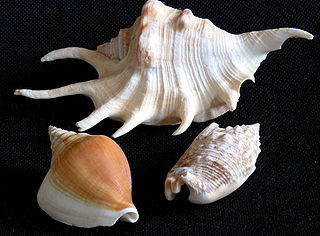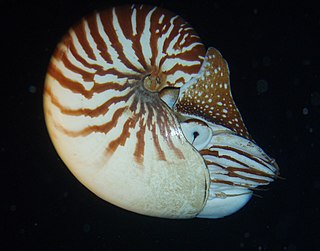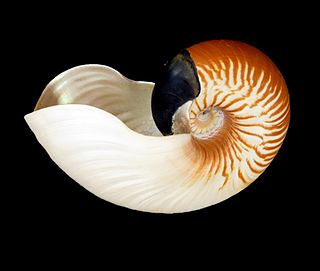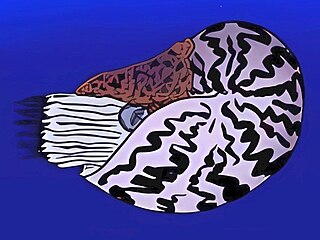
A cephalopod is any member of the molluscan class Cephalopoda such as a squid, octopus, cuttlefish, or nautilus. These exclusively marine animals are characterized by bilateral body symmetry, a prominent head, and a set of arms or tentacles modified from the primitive molluscan foot. Fishers sometimes call cephalopods "inkfish", referring to their common ability to squirt ink. The study of cephalopods is a branch of malacology known as teuthology.

Nautilus are the ancient pelagic marine mollusc species of the cephalopod family Nautilidae. This is the sole extant family of the superfamily Nautilaceae and the suborder Nautilina.

Spirula spirula is a species of deep-water squid-like cephalopod mollusk. It is the only extant member of the genus Spirula, the family Spirulidae, and the order Spirulida. Because of the shape of its internal shell, it is commonly known as the ram's horn squid or the little post horn squid. Because the live animal has a light-emitting organ, it is also sometimes known as the tail-light squid.

In zoology, a tentacle is a flexible, mobile, and elongated organ present in some species of animals, most of them invertebrates. In animal anatomy, tentacles usually occur in one or more pairs. Anatomically, the tentacles of animals work mainly like muscular hydrostats. Most forms of tentacles are used for grasping and feeding. Many are sensory organs, variously receptive to touch, vision, or to the smell or taste of particular foods or threats. Examples of such tentacles are the eyestalks of various kinds of snails. Some kinds of tentacles have both sensory and manipulatory functions.

Coleoidea or Dibranchiata is one of the two subclasses of cephalopods containing all the various taxa popularly thought of as "soft-bodied" or "shell-less". Unlike its extant sister group Nautiloidea, whose members have a rigid outer shell for protection, the coleoids have at most an internal shell called cuttlebone or gladius that is used for buoyancy or as muscle anchorage. Some species, notably incirrate octopuses, have lost their internal shell altogether, while in some it has been replaced by a chitinous support structure.

The argonauts are a group of pelagic octopuses. They are also called paper nautili, referring to the paper-thin eggcase that females secrete; however, as octopuses, they are only distant relatives of true nautili. Their structure lacks the gas-filled chambers present in chambered nautilus shells and is not a true cephalopod shell, but rather an evolutionary innovation unique to the genus. It is used as a brood chamber, and to trap surface air to maintain buoyancy. It was once speculated that argonauts did not manufacture their eggcases but utilized shells abandoned by other organisms, in the manner of hermit crabs. Experiments by pioneering marine biologist Jeanne Villepreux-Power in the early 19th century disproved this hypothesis, as Villepreux-Power successfully reared argonaut young and observed their shells' development.

The chambered nautilus, also called the pearly nautilus, is the best-known species of nautilus. The shell, when cut away, reveals a lining of lustrous nacre and displays a nearly perfect equiangular spiral, although it is not a golden spiral. The shell exhibits countershading, being light on the bottom and dark on top. This is to help avoid predators, because when seen from above, it blends in with the darkness of the sea, and when seen from below, it blends in with the light coming from above.

Nautiloids are a group of marine cephalopods (Mollusca) which originated in the Late Cambrian and are represented today by the living Nautilus and Allonautilus. Fossil nautiloids are diverse and species rich, with over 2,500 recorded species. They flourished during the early Paleozoic era, when they constituted the main predatory animals. Early in their evolution, nautiloids developed an extraordinary diversity of shell shapes, including coiled morphologies and giant straight-shelled forms (orthocones). No orthoconic and only a handful of coiled species, the nautiluses, survive to the present day.

Strombidae, commonly known as the true conchs, is a taxonomic family of medium-sized to very large sea snails in the superfamily Stromboidea, and the Epifamily Neostromboidae. The term true conchs, being a common name, does not have an exact meaning. It may generally refer to any of the Strombidae but sometimes is used more specifically to include only Strombus and Lambis. The family currently includes 26 extant, and 10 extinct genera.

Cephalopod intelligence is a measure of the cognitive ability of the cephalopod class of molluscs.

Nautilus macromphalus, the bellybutton nautilus, is a species of nautilus native to the waters off New Caledonia and northeastern Australia. The shell of this species lacks a callus, leaving the umbilicus exposed, in which the inner coils of the shell are visible. This opening constitutes about 15% of the shell diameter at its widest point.

The Palau nautilus is a nautiloid mainly found off of Palau in the Western Carolines. It can be found on fore reef slopes, at depths of 95m-504m (311'-1,653'), though typically preferring a range of 150m-300m (492'-984'), where water temperatures stay around 16.6 °C (61.88°F) and do not go much lower than 9.4 °C (48.92°F). N. belauensis are highly mobile, epibenthic scavengers and opportunistic predators which rely mostly on scent for finding food. They are active both diurnally and nocturnally within their preferred depth ranges, although most shallow-water incursions are, generally, nocturnal events that coincide with greatly diminished fish activities.

Nautilus is a marine cephalopod genus in the mollusk family Nautilidae. Species in this genus differ significantly, morphologically, from the two nautilus species in the adjacent sister-taxon Allonautilus. The oldest fossils of the genus are known from the Late Eocene Hoko River Formation, in Washington State and from Late-Eocene to Early Oligocene sediments in Kazakhstan. The oldest fossils of the modern species Nautilus pompilius are from Early Pleistocene sediments off the coast of Luzon in the Philippines.

Allonautilus scrobiculatus, also known as the crusty nautilus or fuzzy nautilus, is a species of nautilus native to the waters around New Guinea, specifically New Britain and Milne Bay, and the Solomon Islands. A. scrobiculatus is recognizable by the large open umbilicus, which is around 20% of the shell diameter at its widest point. This species, along with the closely related A. perforatus, were originally placed in the genus Nautilus, but have recently been given their own genus on account of significant morphological differences. The most obvious are features of the shell, including crease and an encrusting layer (periostracum) that covers most of the shell. Gills and reproductive structures also differ significantly from members of the genus Nautilus. The shell is usually up to around 18 cm in diameter, although the largest specimen ever recorded measured 21.5 cm. The species was thought to have gone extinct after 1986, but was rediscovered in July 2015.

Allonautilus perforatus, also known as the Bali chambered nautilus, is a species of nautilus native to the waters around Bali, Indonesia. It is known only from drifted shells and, as such, is the least studied of the six recognized nautilus species. Thus, not much is known about it outside of the shell.

Nautilus cookanus is an extinct species of nautilus. It lived during the Eocene epoch. N. cookanus placed within the genus Nautilus, together with extant species based on their shared shell characters. Fossils of the species from the Late Eocene Hoko River Formation are noted as one of the two oldest occurrences for the genus. Its name has frequently been misspelled as "cookanum".

Nautilus praepompilius is an extinct species of nautilus. It lived from the Late Paleocene through Oligocene epochs. The first fossil specimens discovered in the Late Eocene to Oligocene-aged Chegan Formation of Kazakhstan: an additional, older specimen was found in the Late or Latest Paleocene-aged Pebble Point Formation in Victoria, Australia. N. praepompilius has been grouped into a single genus together with extant species based on their shared shell characters. It is morphologically closest to N. pompilius, hence the name. The nepionic constriction shows that the hatching size was approximately 23 mm, close to that for N. pompilius. N. praepompilius, along with aff. N. cookanum fossils from the late Eocene Hoko River Formation in Washington state are the oldest occurrences of the genus.
Cameroceras is an extinct genus of endocerid cephalopod which lived in equatorial oceans during the entire Ordovician period. Like other endocerids, it was an orthocone, meaning that its shell was fairly straight and pointed. It was particularly abundant and widespread in the Late Ordovician, inhabiting the shallow tropical seas in and around Laurentia, Baltica and Siberia.

All cephalopods possess flexible limbs extending from their heads and surrounding their beaks. These appendages, which function as muscular hydrostats, have been variously termed arms, legs or tentacles.
Trimeroceras is a genus of straight oncocerid from the Silurian of Europe, China, and North America. Originally classified as a part of Gomphoceras, it is now type for the Trimeroceratidae.


















